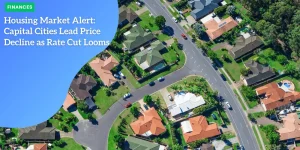Darwin Housing Crisis: Why It’s Now Australia’s Second-Most Expensive City for Renters
Anúncios
Darwin’s Rental Market Overview 
Darwin has climbed the ranks to share the title of Australia’s second-most expensive city for renters, joining Canberra in this dubious distinction.
This milestone is a significant shift, underscoring the competitive nature of the rental market in Australia’s smallest capital city.
Soaring Rental Prices 
The median rent for houses in Darwin has reached $700 per week, reflecting a substantial annual increase of 7.7%.
This price spike is the highest annual rise among all Australian capitals, signaling more than just a hot market—it is increasingly becoming unaffordable for many locals.
Tight Vacancy Rates 
One of the most striking aspects of Darwin’s rental market is its exceptionally low vacancy rate. At just 0.6%, this figure is not only below the national average of 0.8% but also suggests a landlord’s market, where supply significantly trails behind demand.
This limited availability makes it incredibly challenging for prospective tenants to secure housing.
Contributing Factors to the Crisis 
| Factor | Description |
|---|---|
Supply and Demand Mismatch  |
The imbalance between a limited supply of rental properties and growing demand has put upward pressure on rents. |
Transient Population  |
Darwin’s population dynamics, characterized by its temporary residents, contribute to fluctuating rental demand and complicate market stability. |
Affordable Property Purchases  |
Compared to other major cities, Darwin’s property purchase prices are relatively affordable. This affordability attracts homebuyers and investors, increasing the competition for available rental properties. |
Broader Implications 
This rental market situation raises significant concerns for a large proportion of the Northern Territory’s population.
NT Shelter has emphasized that nearly 50% of Territory residents are renters, and the current market conditions exacerbate the housing challenges they face.
With more than 5,000 families on public housing waitlists and an average wait time extending from 4 to 10 years, the strain on affordable housing is palpable.
As Darwin grapples with its new status and the accompanying challenges, understanding these market dynamics is crucial.
Attention must be redirected towards tackling the immediate and long-term solutions necessary to mitigate the crisis and ensure housing stability for all residents.
Factors Driving the Crisis 
Darwin’s rental market crisis doesn’t come out of nowhere.
Several factors contribute to the skyrocketing rental prices and low vacancy rates.
Mismatch Between Housing Supply and Demand 
One major issue driving Darwin’s rental crisis is the significant imbalance between housing availability and need.
As Dr. Nicola Powell, Domain’s research and economics chief, noted, when the vacancy rate falls below 2%, it becomes a landlord’s market.
In Darwin, the vacancy rate is significantly lower at just 0.6%, underscoring the limited availability of rental properties compared to the high demand.
This imbalance creates a competitive environment, leading to rent increases.
Over the past year, Darwin has seen a 7.7% increase in median house rents, now reaching $700 per week, the highest rise among Australia’s capital cities.
With new rental properties not keeping pace with demand, prices continue to rise, leaving renters struggling to find affordable housing.
Darwin’s Unique Transient Population 

Darwin’s transient population also significantly impacts its rental market dynamics.
Many people move in and out of Darwin for work, particularly in sectors like defense, mining, and healthcare.
This constant churn creates a volatile market where rental properties are in high demand but often for short-term stays.
The transient nature of the population means that properties are occupied quickly, contributing to the low vacancy rates.
Additionally, these short-term occupants often need flexible rental agreements, adding to the competitive nature of the market.
Affordable Property Purchase Prices 
Interestingly, despite the rising rental costs, purchasing property in Darwin remains relatively affordable compared to other Australian capitals.
However, this affordability for purchases exerts additional pressure on the rental market.
More people are opting to buy homes, which limits the number of properties available for rent.
This situation is fueled by the fact that rental returns are attractive for investors due to the high rental prices.
As a result, investors are purchasing properties to rent them out rather than to sell, leaving fewer homes available for potential renters who might want to transition to home ownership themselves.
These complex dynamics create a perfect storm, making the rental market in Darwin highly challenging for many residents.
With the mismatch between supply and demand, the transient population, and the relatively affordable property purchase prices, Darwin’s rental market is under significant strain.
This directly impacts local residents and their ability to secure affordable housing.
Impact on Local Residents 
The alarming rise in rental costs in Darwin has had a profound impact on local residents.
The nearly 50% of Territory residents who rent have felt the weight of this crisis as rental prices soar, reaching a median of $700 per week.
This surge in costs has rippled through the community, escalating financial stress and living challenges for many.
Waitlists and Wait Times for Public Housing 
A critical aspect of this rental crisis is the soaring demand for public housing.
More than 5,000 families are currently on public housing waitlists, a number that continues to grow as rental prices push more individuals out of the private rental market.
This demand has resulted in wait times for public housing that can range from 4 to 10 years, placing considerable strain on those in need of affordable accommodation.
Financial Strain 
The financial burden of high rent is substantial for many.
Families and individuals find themselves struggling to allocate a significant portion of their income, often more than 30%, just to cover rent.
For low-income households, this disproportionate allocation leaves them with insufficient funds for other essentials like food, utilities, and healthcare.
The pressure is particularly acute for households with fixed or limited incomes.
Overcrowded Living Conditions 
With the long wait times for public housing and the scarcity of affordable rentals, some residents have been forced into overcrowded living situations.
It’s not uncommon for families to share cramped homes with multiple other families or individuals to rent single rooms at exorbitant prices.
This has led to stressed living conditions, affecting the overall well-being of these residents.
Displacement and Extended Commutes 
This crisis has also seen many residents moving further away from Darwin, seeking more affordable housing options.
Typically, families are moving up to 45 kilometers outside the city.
This displacement comes with extended commutes, adding hours to daily travel times and additional travel costs.
This shift not only strains the finances but also affects the overall quality of life, limiting the time available for family, rest, and recreation.
Forced into Temporary and Unsafe Living Conditions 
The stark reality of Darwin’s rental crisis is seen in stories of residents like Amanda and Mark Elder, who lived in a caravan park for two months before securing a rental property.
This situation is not unique; many are forced into temporary and often unsafe living conditions.
For those who can’t find affordable and secure housing, the risk of homelessness is a looming threat.
Heightened Homelessness Risk 
The ongoing affordability crisis has considerably heightened the risk of homelessness in the Territory.
The homelessness rate in the Northern Territory is already 12 times the national average, illustrating the urgent need for solution.
As rental prices continue to rise and pressure mounts, many fear this crisis will push more residents into homelessness, a dire outcome that demands immediate attention and action.
Transition to Future Solutions 
Without decisive intervention, including increased investment in public housing and policies to address the supply-demand mismatch, the crisis will deepen.
It’s imperative to consider both short-term relief and long-term strategies to ensure that housing remains accessible and affordable for all Territorians.
Addressing these issues now is crucial for stabilizing the rental market and helping local residents regain financial security and peace of mind.
Real Stories from the Crisis 
Living in Caravan Parks 
The recent housing crisis in Darwin has undeniably impacted many families, as evidenced by Amanda and Mark Elder’s experience.
After moving to Darwin in December, they were forced to live in a caravan park for two months while searching for an affordable rental.
This occurred despite Amanda working casually as a nurse and caring for her husband, who is on the disability support pension and recovering from stage 4 brain cancer.
The couple explained that finding a rental within their budget was a near-impossible task.
“We had been applying for houses non-stop around Darwin for places that were within our price range,” Amanda said.
For many local residents, caravan parks have become a temporary solution as they navigate an increasingly competitive rental market.
This scenario is not unique to the Elders, as more families find themselves in similar predicaments, living out of caravans or tents.
These makeshift living conditions are hardly suitable long-term solutions, yet they have become a stark reality for those unable to secure permanent housing in Darwin.
Moving Outside the City 
The pressure on Darwin’s rental market has also forced residents to seek housing far outside the city.
Mark and Amanda Elder eventually found a rental in Noonamah, a rural location approximately 45 kilometers southeast of Darwin.
“If we didn’t get this place, I think we would have been living on the streets or living in my car,” Amanda admitted.
Such relocations are becoming more common as residents look to escape the high rental costs and fiercely competitive market within Darwin.
Those moving to rural areas often face additional challenges, including longer commutes and limited access to city amenities and services.
The impact on quality of life can be substantial, contributing further to the overall stress and difficulties associated with the housing crisis.
Risk of Homelessness 
Perhaps the most alarming consequence of Darwin’s housing crisis is the increasing risk of homelessness.
Nearly 50% of Territory residents are grappling with rising rental costs, which culminates in a stark reality where failure to meet those costs can lead to homelessness.
This is particularly alarming given that the Northern Territory already has a homelessness rate 12 times the national average.
NT Shelter chief executive Annie Taylor emphasized the severity of the issue. “We have a homelessness rate which is 12 times the national average,” she said.
“What we really don’t want to see is people who are already housed becoming homeless because they cannot find affordable housing in the Northern Territory.”
Individuals and families are facing the risk of losing their homes, which adds an emotional and psychological toll on top of the financial strain. This situation necessitates urgent interventions to prevent an even greater housing crisis and ensure that residents have access to affordable housing options.
Addressing these urgent needs is critical for ensuring that every Territorian has access to safe and affordable housing.
Future Challenges and Solutions 
Darwin’s housing crisis isn’t just a current dilemma—it’s poised to become even more pressing with the end of the National Rental Affordability Scheme (NRAS) in June 2026.
This program has been a critical lifeline for many low-income families, offering subsidized rent to ease their financial burden. With its conclusion on the horizon, the rental market will likely face additional stress, amplifying the already dire conditions.
The Urgent Need for Investment 
Investment in public and affordable housing is crucial to mitigating the impending crisis.
NT Shelter advocates for significant increases in this area to help curb the growing risk of homelessness.
With Darwin’s homelessness rate sitting at 12 times the national average, immediate action is essential. Increased funding could lead to the construction of more public housing units, reducing wait times and providing stability for families in need.
Addressing the Structural Issues 
The root of Darwin’s housing troubles lies in a variety of structural issues:
-
Supply and Demand Imbalance
: The mismatch between available housing and the high number of applicants inflates prices and limits options for renters.
-
Transient Population
: Darwin’s unique population dynamics contribute to fluctuating demands, complicating long-term housing strategies.
-
Affordable Property Purchases
: Relatively cheaper property prices attract investors, further squeezing the rental market.
Addressing these factors requires comprehensive policy changes and substantial government investment to ensure that housing remains accessible and affordable for all Territorians.
The Human Impact 
Failure to address these challenges will undoubtedly increase the human cost of the housing crisis.
People like Amanda and Mark Elder, who spent months living in a caravan park, are at risk of experiencing homelessness if affordable rentals remain scarce.
The current situation already forces many families to make difficult choices, such as moving far outside the city or enduring overcrowded living conditions.
Without targeted intervention, these stories will become even more common.
The need for a proactive approach to housing policy and investment is clear if Darwin is to prevent further exacerbation of its rental housing woes.
By deeply understanding the intricate factors contributing to Darwin’s housing crisis, efforts to devise meaningful solutions can be more effectively targeted.













